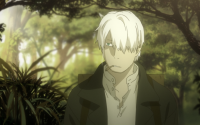New: Devilman Crybaby Review
With Devilman Crybaby, Masaaki Yuasa hits a big shot. It is an avalanche of violence, sex, a youth in the grip of its demons, where the glow of humanity is dispersed. With this series of beastly animation, Netflix releases the first slap of the year. The original “Devilman”, published in 1972, told the story of a shy teenager, Akira Fudo, whose life takes a different turn when he becomes possessed by a demon. With the help of his friend Ryo Asuka, Akira manages to overcome his evil will and use his powers to fight other demons, becoming “Devilman”. The version of Yuasa, meanwhile, true to the plot, is a more modern side of the basic material: more abrupt, more euphoric.
The first episode of the series quickly sets the tone: in a disused area, the youth of the world enjoys wild parties under amphetamine, consumer orgies made of alcohol, sex and drugs. In this nebulous atmosphere battered by a minimal incandescent techno, plastered by a psychedelic or even abstract visual, Devilman Crybaby raises his voice and draws his gore violence during this festival called “Sabbath”. Humanity, behind its volatile morals, opens the door of hell and sees the appearance of demons, literally and cinematographically, that kill the smallest piece of fresh flesh. A total butchery, where the blood lurks the walls shamelessly. Entrance Devilman Crybaby marks the retina with a greasy, burnt aesthetic imprint, with its fertile trans that mixes macabre pleasure with overwhelming dehumanization. Except that visual engraving, its violence, its morbid festivities, its excessive feminine sexualization, is not a simple and timely challenge. Behind this magma that oozes fever, this grandiloquent gamble hides a series that is teeming with ideas, and holds a sensation of almost total perdition. Devilman Crybaby is a nameless slap, which sprinkles his aura with a human and nihilistic breathing. The stake is there: the meanders of humanity. Where is the demon in us? Where is the limit of our humanity?

In this fatal interrogation, the series does not bog down in a deep psychoanalysis, but builds on what it does best: proposing endearing characters but gangrened by a hatred that will push them to climb the slider of violence. Akira and Ryo, the best friends in the world will gradually tear themselves apart because their visions of the world turn out to be different. One wants to save the world while a demon lives in it and the other wants to see the birth of chaos. Good and evil are one. Yet under their human envelopes, feeds a bitter and carnivorous demon. With its short format, nonchalance gore, race against the clock, Devilman Crybaby recalls the thirsty pleasure that the Lastman series could provide. But the animated series wants to be darker, more disarticulated in its realization, less focused on the burlesque aspect: black is black according to the adage.
This demonic farandole, this debauchery of excess, this animated epileptic action, never seems gratuitous in the light of the psychological violence that emanates from the characters. Just like Satoshi Kon’s Paranoia Agent, the series is not just a defiler: but a portrait of a competing society, a youth pushed to its limits, as voyeuristic as it is deviant, who abandons his people and lives in the world. accumulation of regrets. Devilman Crybaby has that immeasurable smell of self-destruction. Certainly, the theme, this hatred of the human being that emerges from the series is not new. But the coherence presented between the baroque line and the theme is impressive and makes everything impressive, as could the bloody animations movies like Yoshiaki Kawajiri’s Ninja Scroll.


